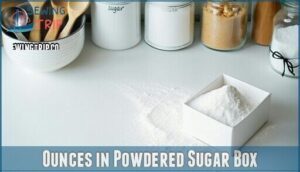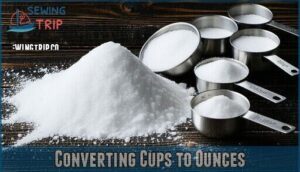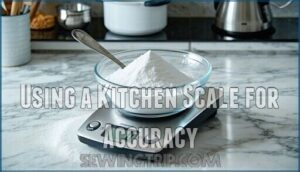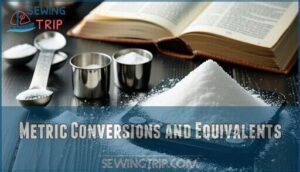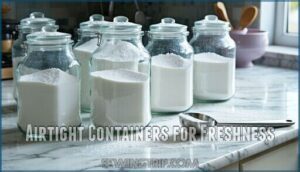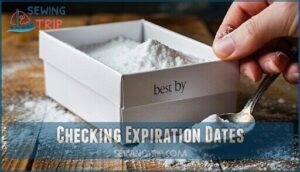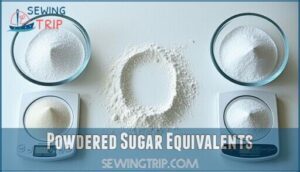This site is supported by our readers. We may earn a commission, at no cost to you, if you purchase through links.
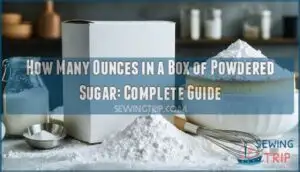 A standard box of powdered sugar contains 16 ounces, which equals one pound. You’ll find this size in most grocery stores.
A standard box of powdered sugar contains 16 ounces, which equals one pound. You’ll find this size in most grocery stores.
Some brands offer smaller 8-ounce boxes or larger 32-ounce containers for bigger baking projects. The weight stays the same whether your powdered sugar looks fluffy or packed down in the box.
This matters because recipes often call for specific amounts, and you don’t want your frosting turning out too thick or thin. Most home bakers stick with the 16-ounce box since it’s perfect for making buttercream frosting or dusting desserts.
Understanding proper measurement techniques can make your baking results more consistent.
Table Of Contents
Key Takeaways
- You’ll find exactly 16 ounces in a standard box of powdered sugar, which equals one pound and works perfectly for most home baking recipes.
- You can expect about 4 cups of powdered sugar from a 16-ounce box, but you’ll get more accurate results using a kitchen scale since volume measurements can vary based on how packed the sugar is.
- You’ll need to store your powdered sugar in airtight containers in cool, dry places to prevent clumping and maintain that fine texture you need for smooth frostings and glazes.
- You can’t directly substitute granulated sugar for powdered sugar in recipes – you’ll need to use 1¾ cups of powdered sugar for every cup of granulated sugar due to density and texture differences.
Powdered Sugar Basics
You’ll find powdered sugar in most baking recipes because it dissolves quickly and creates smooth textures in frostings and glazes.
This fine sugar contains cornstarch to prevent clumping and weighs less than regular granulated sugar due to its different density.
Definition and Properties
Powdered sugar breaks down granulated sugar into fine particles that dissolve instantly in your recipes.
This confectioners sugar contains cornstarch content to prevent clumping and creates smooth textures. Its sugar density differs substantially from regular sugar due to air pockets between particles.
The dissolving rate surpasses granulated sugar, making it perfect for frostings. Molasses absence keeps the color pure white, ensuring texture impact in delicate desserts.
Types of Sugar and Density
Different sugar types have varying sugar density levels that affect your baking measurements.
Granulated sugar weighs more per cup than powdered sugar due to granulation impact.
Brown sugar contains molasses content, making it denser and affecting sweetness levels.
When using sugar substitutes, you’ll need different ounce conversions.
Understanding these confectioners sugar weight differences helps you measure accurately for better results.
Common Uses in Baking and Cooking
You’ll find powdered sugar shines in frosting applications and glaze recipes where smooth texture matters most.
Dessert dusting transforms plain cakes into bakery-worthy treats.
It stabilizes whipped cream and creates silky confectionery uses like truffles.
When measuring powdered sugar ounces for baking ingredients, remember that box of sugar weight affects your powdered sugar conversion calculations for perfect results.
Ounces in Powdered Sugar Box
Most boxes of powdered sugar contain exactly 16 ounces, which equals one pound.
Your standard grocery store box delivers exactly one pound of sweet, silky powder ready for baking magic.
This Box Weight Standards applies across nearly all major brands you’ll find at the grocery store.
You won’t see much variation in Packaging Variations regarding standard retail boxes.
Whether you grab Domino, C&H, or store brands, the powdered sugar ounces remain consistent at 16 ounces per box.
This makes recipe planning straightforward since you know what you’re getting.
However, Brand Differences do exist in Commercial Sizes and Bulk Purchases.
Restaurants and bakeries often buy larger quantities in 2-pound, 4-pound, or even 25-pound bags.
These bigger packages offer better value for heavy users.
When checking ounces in sugar at the store, look at the weight printed on the package.
The box of sugar weight is clearly marked, making powdered sugar conversion calculations easier for your recipes.
Measuring Powdered Sugar
You need accurate measurements when working with powdered sugar because weight and volume don’t always match up the same way.
A kitchen scale gives you the most precise results since one cup of powdered sugar weighs about 4 ounces but can vary depending on how much you pack it down. Powdered sugar and complete concepts.
Converting Cups to Ounces
Converting cups to ounces requires understanding Volume vs. Weight differences. Density Impact affects conversions since powdered sugar weighs less than granulated sugar.
Packing Variations change measurements too. You’ll multiply cups by 4.5 to get powdered sugar ounces.
One may need to convert cups accurately for baking. Sugar measurement conversion helps with Recipe Adjustments.
Standard Measurement Tools work but remember confectioners sugar weight varies by how tightly packed it sits.
Using a Kitchen Scale for Accuracy
A kitchen scale eliminates guesswork when measuring confectioners sugar weight. Digital scales offer better weight consistency than analog versions for recipe precision.
A kitchen scale is your secret weapon for flawless baking—no more guessing, just perfect results every time.
Here’s how to use your scale effectively:
- Scale calibration – Check accuracy with a known weight before baking
- Tare function – Zero out your bowl’s weight first
- Weight measurements – Place sugar directly for exact sugar to ounces conversion
Metric Conversions and Equivalents
When you’re working with international recipes, metric conversion becomes your best friend.
One ounce equals 28.35 grams, so your 16-ounce box contains about 454 grams of powdered sugar.
Since density impacts volume conversions dramatically, that same box gives you roughly 960 milliliters when measured.
These sugar weight conversion numbers help guarantee measurement accuracy across different recipe formats and kitchen scales worldwide.
Many people find sugar conversion products helpful for baking.
Storing Powdered Sugar
You’ll want to store your powdered sugar in a cool dry place to prevent clumping and moisture damage.
Keep it in an airtight container and check the expiration date to guarantee your baking results stay consistent.
Cool and Dry Environment
Store your powdered sugar in ideal conditions to maximize shelf life and prevent clumping.
Humidity control is essential since moisture turns your sugar into concrete-hard lumps.
Here are key storage requirements:
- Keep temperature between 60-70°F away from heat sources
- Maintain humidity levels below 60% using dehumidifiers if needed
- Choose pantries or cabinets away from stoves and dishwashers
To help maintain proper humidity, consider pantry dehumidifier options.
Proper conditions preserve sugar box weight and prevent waste by keeping the environment stable, which is crucial for storing sugar in a pantry.
Airtight Containers for Freshness
Once you’ve found the right cool and dry spot, you’ll need proper storage containers.
Airtight containers prevent humidity from sneaking in and turning your powdered sugar into rock-hard clumps.
Glass jars or plastic containers with tight-fitting lids work best, as these container materials keep moisture out while preserving that fine texture you need for perfect frostings and glazes.
Checking Expiration Dates
Beyond proper containers, checking dates helps guarantee peak freshness for your baking results.
Most powdered sugar boxes show "best by" dates rather than true expiration dates.
Sugar rarely spoils but loses quality over time.
Visual inspection matters too – look for clumps or discoloration.
Storage impact affects texture and performance.
Fresh sugar delivers better results in your favorite recipes.
Powdered Sugar Equivalents
You’ll find that powdered sugar goes by several names in recipes and different regions call it different things.
Understanding these equivalent terms helps you follow any recipe without confusion and know when you can substitute one type of sugar for another.
Interchangeable Terms in Recipes
Different recipe sources use various names for the same ingredient, which can confuse home bakers.
Understanding these interchangeable terms helps you navigate recipes from different countries and cookbooks with confidence.
Here are the most common terms you’ll encounter:
- Confectioners Sugar – Standard American terminology found in most US recipes
- Icing Sugar – British and Canadian term meaning identical ingredient and measurements
- Powdered vs. Castor – Powdered is finely ground while castor is superfine granulated
- 10X Sugar – Ultra-fine powdered sugar with consistent ounces per box
- Terminology Impact – Recipe success depends on using correct sugar type for texture
Regional Variations in Terminology
Powdered sugar goes by different Global Names worldwide. In Britain, you’ll find "icing sugar" while Australians call it "pure icing sugar." French recipes use "sucre glace" and Germans say "puderzucker."
These Cultural Recipes variations don’t change the sugar weight chart – a standard package size remains 16 ounces regardless of terminology.
| Region | Term | Package Size |
|---|---|---|
| United States | Powdered Sugar | 16 ounces |
| United Kingdom | Icing Sugar | 454g (16 oz) |
| Australia | Pure Icing Sugar | 500g (17.6 oz) |
| France | Sucre Glace | 500g (17.6 oz) |
| Germany | Puderzucker | 500g (17.6 oz) |
Brand Differences exist but Historical Origins show Terminology Evolution across cultures maintains consistent powdered sugar volume measurements.
Substituting Granulated Sugar in Recipes
Substituting granulated sugar for powdered creates texture differences you’ll notice immediately.
Granulated sugar’s larger crystals impact moisture content and sweetness levels differently than fine powder.
For recipe adjustments, use 1¾ cups powdered sugar per cup granulated sugar.
The granulation impact affects volume conversion substantially. Remember that sugar volume and weight of sugar measurements change your final results completely.
Frequently Asked Questions (FAQs)
How many ounces are in 1 box of powdered sugar?
As they say, measure twice, cut once.
You’ll find exactly 16 ounces in a standard box of powdered sugar.
That’s your typical one-pound package, perfect for most baking recipes requiring confectioner’s sugar.
Is a 16 oz box of powdered sugar 2 cups?
No, a 16 oz box of powdered sugar equals about 4 cups, not 2 cups. You’ll get roughly 4 ounces per cup since powdered sugar is much lighter than granulated sugar.
How many cups in a box of powdered sugar?
You’ll find approximately 4 cups in a standard 16-ounce box of powdered sugar.
This measurement assumes you’re using unsifted sugar with level scoops.
Sifting can increase the volume slightly due to aeration.
How much does a box of powdered sugar weigh?
A standard box of powdered sugar weighs 16 ounces, which equals one pound.
You’ll find this consistent weight across most major brands, making it easy to plan your baking recipes and shopping lists, with complete concepts like this being particularly useful.
How many ounces are in a pound of powdered sugar?
A pound of powdered sugar equals 16 ounces.
This measurement stays consistent whether you’re buying a standard box or bulk bag.
You’ll find this ratio helpful when scaling recipes up or down for baking projects.
How many cups in 16 ounces of powdered sugar?
Sixteen ounces of powdered sugar equals about four cups when measured properly.
You’ll get the most accurate results by gently spooning the sugar into your measuring cup without packing it down tightly, which helps ensure complete concepts are applied for the best outcome.
How many calories are in a ounce of powdered sugar?
You’ll find about 120 calories in each ounce of powdered sugar.
That’s roughly 30 calories per tablespoon since there are four tablespoons in an ounce.
It’s pure carbohydrates with no fat or protein.
How much sugar is in a 32 ounce box?
How much sweetness are you working with?
A 32-ounce box contains exactly 32 ounces of powdered sugar—that’s double the standard 16-ounce size.
You’ve got enough confectioner’s sugar for multiple batches of frosting or glazes.
How many cups of powdered sugar in a pound?
You’ll get approximately 75 cups of powdered sugar from one pound. Since it’s lighter than granulated sugar, it takes up more space. Always sift first to remove lumps for accurate measuring.
How much granulated sugar is in a 1 pound box?
Like treasure in a chest, granulated sugar’s density differs from powdered.
You’ll find approximately 25 cups of granulated sugar in a one-pound box, since it’s denser and packs tighter than its powdered counterpart.
Conclusion
Baking success often hinges on precise measurements, just like a well-tuned recipe.
Now you know exactly how many ounces in a box of powdered sugar – typically 16 ounces for standard boxes.
You can confidently tackle any recipe that calls for powdered sugar. Remember to store your sugar properly in airtight containers.
Use a kitchen scale when precision matters most. With these measuring tips, your frostings and baked goods will turn out perfectly every time.

